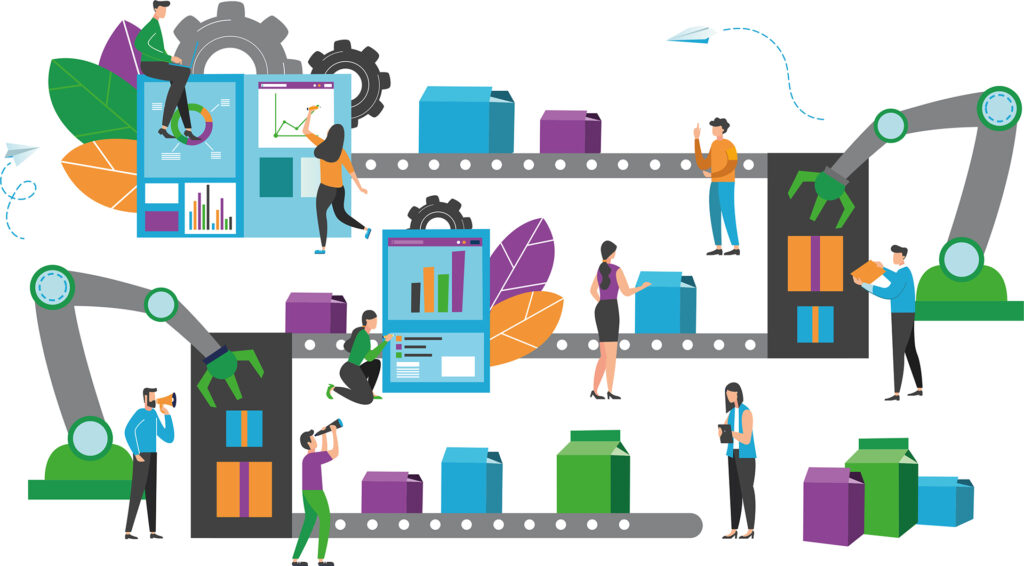How manufacturers are integrating digital transformation technologies
Faced with rising economic concerns like inflation and supply chain issues, the manufacturing sector is under constant pressure to increase efficiency and productivity while reducing costs. The advent of new technological innovations like automation, robotics, and AI are providing countless ways to introduce improvements throughout the manufacturing process to unlock new business outcomes.
The benefits of automation have yielded numerous examples of triple digit gains in output, so it’s no surprise that the market for manufacturing automation is growing at an unprecedented clip. According to Precedence Research, the global industrial automation market size was estimated at $196.6B in 2021 and is expanding to surpass $412.8B by 2030, growing at a CAGR of 8.59% during the forecast period 2022 to 2030.1
Here are six key trends in manufacturing automation for 2023 that are driving this dramatic growth:
Artificial intelligence
Rapid advancements in technologies like AI have allowed enterprises and government agencies to gather and analyze large volumes of real-time data. The resulting insights and efficiency gains have been major drivers in AI manufacturing global revenue growth. The market size for global AI manufacturing was $2.60B in 2022 and is expected to grow to $102.66B by 2032.2 The most pervasive use cases, according to the research, were intelligent maintenance, quality control, and demand planning.
Additive manufacturing
Utilizing AI/ML, data modeling, and analytics, additive manufacturing is a quickly growing trend with applications across many industries like healthcare, biomedical, and industrial manufacturing sectors. Most frequently referred to as 3D printing, additive manufacturing uses computer aided design (CAD) software to build custom products one layer at a time. Typical use cases include formulating prototypes, models, individual components or completely finished products. It’s grown in popularity because of the significant time savings in rapidly churning out inexpensive components. One example in the metal fabrication industry is the utilization of selective laser sintering (SLS) 3D printing to produce highly accurate and durable parts using inexpensive materials like nylon for the mass production of metallic components.
Collaborative robots or cobots
When the trend of adding robots to assist with assembly in manufacturing initially emerged, there were many who speculated they would replace skilled workers and eliminate jobs. This has not typically been the case – in many instances cobots are not only supplemental to existing skilled laborers, they also serve to offload high-risk, physically demanding work, allowing people to focus on skilled tasks. The result is a collaborative workforce that can get more work done, faster, and more safely. Cobots not only handle dangerous jobs on behalf of their human colleagues, they also minimize factory downtime by operating around the clock if necessary.
Dark factories
Dark factories and lights-out manufacturing are said to have earned these names because they are fully automated facilities that operate independently and entirely in the absence of human beings. This isn’t entirely true, as most dark factories still require the presence of human workers for removing completed parts and setting up containers and bays that hold unfinished parts. As the technology necessary for total automation has become increasingly available, many factories are beginning to use lights-out manufacturing between shifts to meet increasing production demand. In the case of a China-based manufacturer, Changying Precision Technology, they used AI and robotic arms in a fully automated dark factory that ran 24/7/365 and increased productivity by 250%.3
Industrial IoT (IIoT)
Industrial IoT or IIoT helps manufacturers connect and monitor industrial assets like machinery, shop floors, and inventory with embedded software and built-in sensors for collecting, exchanging, and analyzing data, allowing them to gain key insights for optimization. This enables manufacturers to collect and centrally analyze data from various machines and equipment in the factory, allowing them to identify trends and areas for improvement. One example of IIoT in action is the live monitoring of garbage containers in smart cities. Utilizing distributed sensors and a centralized monitoring dashboard in a cloud environment allows smart cities to only roll trucks to full containers when necessary, saving time, fuel, and wear and tear on equipment.
Predictive maintenance
Another area where IIoT has drastically improved manufacturing is around predictive maintenance. IoT-enabled predictive maintenance sensors can help improve the efficiency and safety of manufacturing operations. These wireless sensors monitor vibration, temperature, acceleration, and sound frequencies to detect if the machines are operating under normal conditions. Monitoring equipment usage patterns and anomalies provides the ability to predict when equipment is nearing its breaking point. By proactively replacing worn parts, manufacturers are reducing downtime due to equipment failures.
Conclusion
Automation in manufacturing has taken massive strides just the last few years with the benefit of automation, IoT, AI/ML, data mining and analytics. As demonstrated in the previous six trends we’ve seen huge gains in production, quality, efficiency, accuracy, and customer satisfaction while dramatically lowering safety risks, operational costs, wasted time and required energy resources. These gains were only achievable through the combination of automation and IoT in manufacturing. In short, by embracing automation, manufacturers can remain competitive, adapt much more quickly to changing market conditions, improve profitability, and have a much better chance of achieving long-term success.
- Precedence Research, Industrial Automation Market, September 2022
- Emergen Research, Artificial Intelligence in Manufacturing Market, Forecast to 2032, February 2023
- Inventment U, How Dark Factories Are Changing Manufacturing (and How to Profit), October 2019
